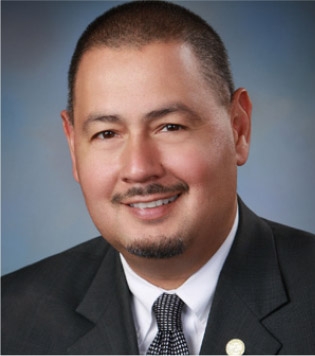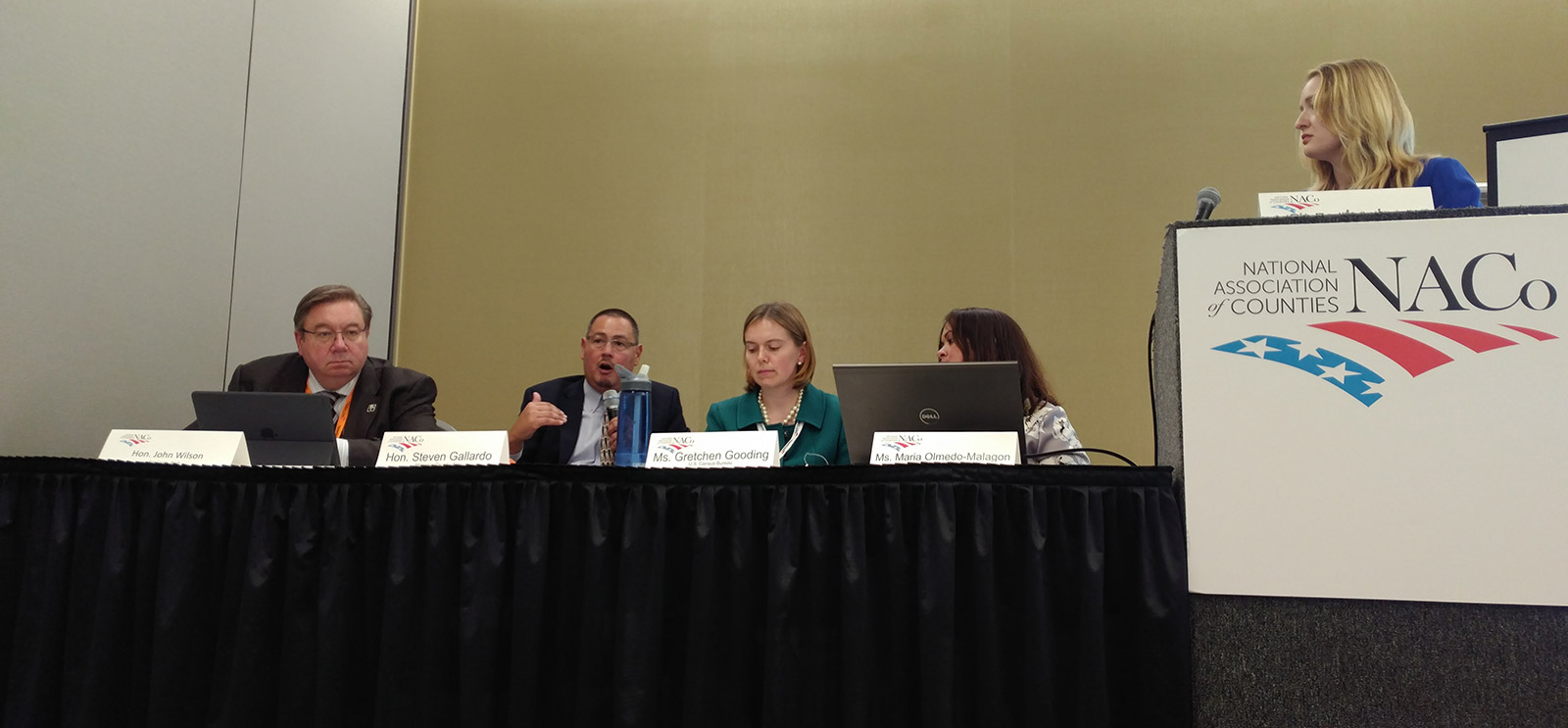Everyone Counts: How 2020 Census Data Matter to Your Bottom Line
Upcoming Events
Related News
Introduction
The 2020 Census is coming around – and counties need to prepare. The census population counts have major implications for how a large portion of federal dollars are distributed to states and local governments, as well as for congressional redistricting and for enforcing civil rights laws. The decennial census has a major effect on counties and county leaders can play a significant role in the effective rollout of the census.
At NACoâs 2017 Annual Conference, the Counties Futures Lab and the International Association of Assessing Officers (IAAO) hosted a session on the significance of the decennial census to counties, the rollout of the 2020 Census and how county officials can help the process. Steven Gallardo, Supervisor, Maricopa County, Ariz., and John Wilson, Assessor, King County, Wash. provided the county perspective. Maria Olmedo-Malagon, Program Manager, 2020 Census Communications Campaign, U.S. Census Bureau and Gretchen Gooding, Survey Statistician, American Community Survey (ACS) Office, U.S. Census Bureau shared their expertise on the significance of the census and the ACS. Ms. Olmedo-Malagon provided a presentation on the decennial census and ACS, with a focus on the 2020 Census (See âThe 2020 Census: Preparing for the Road Aheadâ) presentation.
Map 1. Distribution of Federal Funding from 16 Large Census-Guided Federal Programs, FY 2015
Source: Andrew Reamer, “Counting for Dollars 2020: The Role of the Decennial Census in the Geographic Distribution of Federal Funds” (Washington, D.C.: The George Washington Institute of Public Policy, 2017).1
What are the Decennial Census and ACS?
Since 1790, the United States has undertaken a count of population once every decade, as required by the U.S. Constitution.2
The 2020 Census aims to count all population and housing. The federal government and other stakeholders use decennial census information to:
- Apportion representation among states.
- Allocate approximately $600 billion in federal funding. In federal fiscal year 2015, the federal government distributed $589.7 billion from 16 large census guided programs, such as Medicaid, Highway Planning and Construction, and Foster Care (See Map 1).3 Previous research identified 215 federal financial assistance programs used census-derived data to determine distribution of federal funding.4
- Determine eligibility for federal grants and programs.
- Establish the boundaries of congressional districts, state legislative districts, school districts, and locate voting precincts.
- Inform government planning decisions and business location selections.
The federal government is allocating about $600 billion dollars per year based on census programs.
– Gretchen Gooding, Survey Statistician, American Community Survey (ACS) Office, U.S. Census Bureau

The 2010 Census was the first one to use only a short form focused on demographics, leaving the American Community Survey (ACS) to collect socioeconomic and housing information instead of the decennial long form. Not only does ACS data provide a larger variety of information, they also help fill the gaps for years when a decennial census is not conducted.
- ACS data is released annually, while census data is released every decade.
- ACS collects a wider array of data, which is not captured in the census.
- Many federal agencies use both decennial census and ACS data to allocate funds and determine eligibility for counties and other entities.
NACo supports nationwide implementation of the ACS to improve the utility of census data and permit more frequent releases of data to demonstrate emerging local and regional trends.
How County Officials Can Help with the Decennial Census and ACS
1.
Get Involved in the Local Update of Census Addresses (LUCA)
The accurate counting of the entire U.S. population where each person lives is the core of the decennial census. The U.S. Census Bureau needs the latest accurate addresses for all households in the United States to accomplish this goal. The Local Update of Census Addresses (LUCA) is essential in this process.5 This program gives local government leaders the opportunity to review and comment on the Census Bureau’s residential address list for their communities before the rollout of the decennial census.
The LUCA program is your time to participate in the census. You know your community better than we do.
– Maria Olmedo-Malagon, Program Manager, 2020 Census Communications Campaign, U.S. Census Bureau

County leaders, together with tribal, state, city and township officials have the opportunity participate in LUCA. In this way, county leaders ensure an accurate count of all the population in their community. The U.S. Census Bureau sent the LUCA invitation and forms to the highest elected official in the county during July 2017.
During the workshop, Assessor Wilson provided an example of how census data benefitted his county in the past. Because of rising home prices many seniors encountered difficulties in keeping up with assessments. While King County has a senior exemption program, it was not clear to what extent it was being used by residents. Assessor Wilson leveraged census data to do just that – and found that a small proportion of eligible seniors were making use of the program. By increasing engagement with this demographic, Assessor Wilson managed to keep people in their homes.
The National Association of Counties (NACo) supports the U.S. Census Bureau’s Local Update of Census Addresses (LUCA) Program and encourages county governments to participate in the 2020 LUCA program to ensure all addresses in their communities appear in the Census Bureau’s Master Address File.
Click here for a fullscreen map of LUCA participants. Click here for LUCA forms sent to counties and other state, local and tribal officials.
To register for LUCA, the highest elected official in the county needs to return the complete forms to the U.S. Census Bureau by December 15, 2017. For questions, please contact U.S. Census at 1.844.344.0169 or Geo.2020.LUCA@census.gov.
2.
Encourage Your Residents to Respond to the 2020 Census and ACS
An accurate census count, or lack thereof, has a lasting effect on a county, from the allocation of federal funding to redistricting. For example, an under-counted population may lead to a significant decline in federal funding flowing to the county government or to county residents. Ultimately, this decline may last a decade until the implementation of the next census results, as stated by Ms. Olmedo-Malagon.
We should be having these conversations now - what are we doing as local officials to assist the Census Bureau by ensuring trust from the public?
– Steven Gallardo, Supervisor, Maricopa County, Ariz.

Both rural and urban counties need to get engaged for a successful rollout of the 2020 Census, as stressed by Assessor Wilson. An undercount is often the result of residents not responding to filling out the decennial census. The same situation applies to the annual ACS. This may affect hard to reach and rural communities to a larger degree, especially sparsely populated counties where enumerators have a hard time contacting households. The response rates have significantly declined over the past censuses from almost 80 percent in 1970 down to 63 percent in 2010.6 U.S. Census Bureau presenters Gretchen Gooding and Maria Olmedo-Malagon recommended counties to work closely with the U.S. Census Bureau to encourage response from their constituents.
Supervisor Gallardo stressed the importance of public trust as we move forward into the 2020 Census. The most effective method to increase participation is to ensure residents are comfortable with responding. Elected officials have a major role in building this trust in the decennial census in their communities, through their role as conveners and leaders across a wide range of local organizations.

3.
Inform Your Federal Representatives About the Significance of the 2020 Census and ACS to Your County
The U.S. Census Bureau is facing several challenges with the 2020 Census. These include declining response rates, technological change and fiscal constraints. With falling response rates and growing population numbers, the U.S. Census Bureau had to invest more in household visits in recent censuses to match the results of previous decades. For example, in 2010, census enumerators made over 100 million visits resulting in a cost of $94 per housing unit (in 2010 dollars).7 The 2010 census was the most expensive at about $12.3 billion, about 31 percent costlier than the previous one.8
The U.S. Census Bureau created a plan to reduce costs and increase efficiency for the incoming decennial census. Some of the innovations include using the internet as a self-response option, verifying more addresses using “in-office” methods instead of field canvassing, use automated case management systems for data collection and use of existing administrative data instead of asking in the enumeration.9 While accompanied by significant risks, if successful, this redesign would reduce costs by over $5 billion dollars from the cost of conducting the decennial census using the 2010 design and methods. 10
Reach out to your members of Congress to talk about the importance of the 2020 Census.
– John Wilson, Assessor, King County, Wash.

As 2020 draws near, preparations for the decennial census are ramping up. In the past, the decennial census funding reflected this cycle to ensure adequate preparation for the count. The U.S. Census Bureau requested $800.174 million for the 2020 Census for FY2018.11 With all the challenges ahead, 2020 Census needs broad-based support. Supervisor Gallardo stated that county leaders can “encourage them [Congress] to properly fund the census.” NACo encourages full funding for the Census Bureau and is part of the Census Project, which is a coalition of organizations across the country that supports a fair and accurate decennial census and comprehensive ACS.
Counties will continue to partner with their Congressional representatives in supporting a fair and accurate decennial census and ACS. Reminding representatives about the significance of the census and ACS to their constituents can ensure a successful rollout. Strengthening the local-state-federal partnership would only help these national efforts.
Takeaways
Get Involved.
Counties are strongly encouraged to participate in the Local Update of Census Addresses (LUCA).
Encourage Your Residents to Participate in the 2020 Census and Acs.
Counties will benefit directly from an exact count of their residents where they live.
Inform Your Federal Representatives About the Significance of the 2020 Census and Acs to Your County
A strengthened local-state-federal partnership would help the rollout of the national efforts.
Counties can play their part in the 2020 Census and ACS rollouts by participating in LUCA and encouraging residents to respond to census forms, enumerators, and to provide accurate data. County officials and residents alike are also encouraged to contact their representatives in Congress to inform them of the importance of the decennial census and ACS for their county. Putting forth the effort now will pay dividends to counties, who rely on census counts for planning purposes as well as census-guided federal funding. With support from the counties, local governments, states and U.S. Congress, the Census Bureau will be able to meet the constitutional mandate under increasing constraints.
Endnotes
[1] Map 1 shows federal funding from only 16 federal assistance programs received within a state by a state government, other entities and individual beneficiaries. These 16 large federal assistance programs that distribute funds based on decennial census-derived data are: Medicaid, Supplemental Nutrition Assistance Program (SNAP), Medicare Part B, Highway Planning and Construction, Section 8 Housing Choice Vouchers, Title I Grants to Local Education Agencies, National School Lunch Program, Special Education Grants (IDEA), State Children’s Health Insurance Program (S-CHIP), Section 8 Housing Assistance Payments Program (Project-based), Head Start/Early Head Start, Supplemental Nutrition Program for Women, Infants, and Children (WIC), Foster Care (Title IV-E), Health Center Program, Low Income Home Energy Assistance (LIHEAP), and Child Care and Development Fund- Entitlement. For more see Andrew Reamer, “Counting for Dollars 2020: The Role of the Decennial Census in the Geographic Distribution of Federal Funds” (Washington, D.C.: The George Washington Institute of Public Policy, 2017).
[2] Article I, Section II of the U.S. Constitution mandates the taking of the decennial census the following “Representatives and direct Taxes shall be apportioned among the several States which may be included within this Union, according to their respective Numbers […]. The actual Enumeration shall be made within three Years after the first Meeting of the Congress of the United States, and within every subsequent Term of ten Years, in such Manner as they shall by Law direct.”
[3] Andrew Reamer, “Counting for Dollars 2020: The Role of the Decennial Census in the Geographic Distribution of Federal Funds” (Washington, D.C.: The George Washington Institute of Public Policy, 2017).
[4] Andrew Reamer, “Counties for Dollars: The Role of the Decennial Census in the Geographic Distribution of Federal Funds” (Washington, D.C.: Metropolitan Policy Program, The Brookings Institution, 2010).
[5] U.S Census Bureau, “2020 Census Local Update of Census Addresses Operation (LUCA)” (2017), available https://www.census.gov/geo/partnerships/luca.html (August 10, 2017)
[6]U.S. Government Accountability Office (GAO), 2017 High Risk Report- 2020 Decennial Census (GAO, 2017), available at http://www.gao.gov/assets/690/682765.pdf
[7] U.S. Census Bureau, “Alternative Futures for the Conduct of the 2030 Census” (2016), available at https://www.census.gov/programs-surveys/decennial-census/2020-census/planning-management/final-analysis/alternative-futures-2030-census.html (September 1, 2017)
[8] GAO, 2017 High Risk Report- 2020 Decennial Census.
[9] U.S. Census Bureau, “2020 Census Operational Plan”(2015), available at https://www2.census.gov/programs-surveys/decennial/2020/program-management/planning-docs/2020-oper-plan.pdf (September 1, 2017)
[10] GAO, 2017 High Risk Report- 2020 Decennial Census.
[11] U.S. Census Bureau, U.S. Census Bureau’s Budget Fiscal Year 2018, as presented to Congress, May 2017, Appropriation Account: Periodic Censuses and Programs, Demographic Statistics Programs Overview, Table: Budget Summary Table for 2020 Census, p.79, available at https://www2.census.gov/about/budget/FY2018-census-budget.pdf (September 1, 2017)
Acknowledgments
The authors would like to thank Hon. Steven Gallardo (Maricopa County, Ariz.), Gretchen Gooding (U.S. Census Bureau), Maria Olmedo-Malagon (U.S. Census Bureau), and Hon. John Wilson (King County, Wash.) for their presentations during the workshop that form the basis of this report. Within the National Association of Counties, the authors would like to thank Jack Peterson for his helpful comments. The authors also express their appreciation to their Public Affairs colleagues for the graphic design and the website of the report.
For more information:
About the Counties Futures Lab
The NACo Counties Futures Lab brings together leading national experts to examine and forecast the trends, innovations and promises of county government with an eye toward positioning Americaâs county leaders for success. Focusing primarily on pressing county governance and management issues â and grounded in analytics, data and knowledge sharing â the Lab delivers research studies, reports and other actionable intelligence to a variety of venues in collaboration with corporate, academic and philanthropic thought leaders to promote the county government of the future.